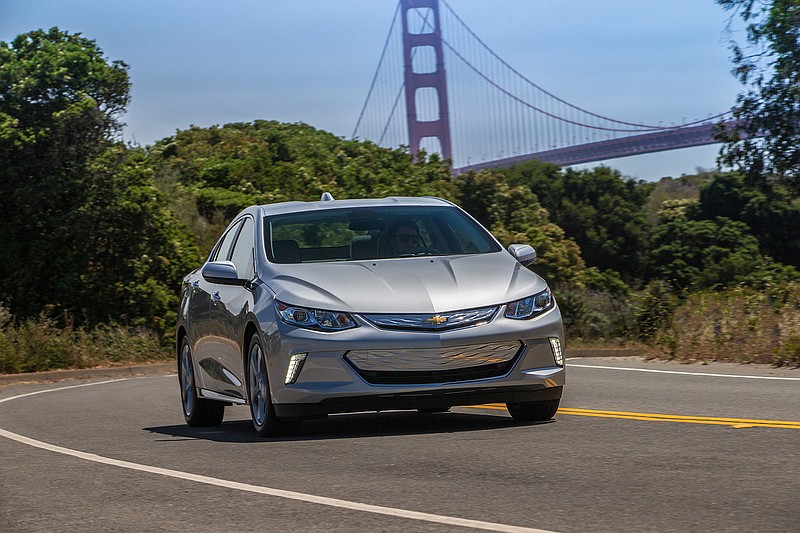The Volt is a better car than you think.
That was true when Chevy's plug-in electric-hybrid hit the streets in 2011, and more so now with the second-generation Volt, which is better in every nook and cranny, and nicer on the eye, too.
The Volt has a similar wheelbase and interior dimensions as the Honda Civic, but with a much larger trunk. The two cars are similar in other ways. Both are well manufactured and light on their feet, making them a pleasure to drive.
Both are fuel champs. The Civic will go about 520 miles on 12.4 gallons of gas, which will get you from Texarkana to Austin and back to about Dallas. Chevy says most owners will get about 1,000 miles on an 8.9-gallon fill-up, which will get you from Texarkana to Austin, back to Texarkana, and back to about Round Rock.That's just an estimate, of course, because calculating fuel economy on a Volt requires what mathematicians call a step function. The car uses zero fuel while the batteries are charged, and then gets 42 mpg on a 1.5-L Atkinson Cycle DOHC I-4.
Chevy says the battery will get you about 52 miles, but I never found out. The most I put on during my week with this felicitous automobile was 35 miles. There was usually about a fourth of the charge left when I pulled into my driveway and plugged her into a 110 outlet. The next morning, she was charged up and ready to go.
The gas gauge was still on F when the nice man came to retrieve her.
The only time I used the gas engine was late one night when I wanted to see how fast this thing would take off from a stop light. It wasn't my idea. The car talked me into it.
Electric motors are nearly silent and have incredible torque, the power used on take-off. The Volt's twin-motor electric drive puts out 294 pounds of torque. That's similar to most mid-sized pickups. The most you can get out of a new 4Runner is 278 lb.-ft.Since there are no gears to shift, the Volt feels as silky smooth and powerful as a top-drawer Mercedes. The electric drive train is engineered to deliver peak torque in the 0-30 range. So driving around town, this car was simply seducing me. Do you see why I had to know what this thing would do?
Smashing the pedal to the floor signaled the engine to kick in and give the electric motors a handwhich I only knew from a dash display. As with the previous Volt, engine starts are almost imperceptible inside the cabin.
The Volt peeled away from the line like a pocket rocket, chirping the tires a few times on take-off and streaked to 60 mph in less than 8 seconds, give or take. That means that if you and your neighbor with a 6-cylinder Honda Accord want to go drag racing, it's going to come to down to reaction
times.
Can't you just picture that? Suburbia unleashed.
Of course, you're not going to buy a Volt to go drag racing. (If you do, let me know. I want to come watch. My advice: Keep your eyes on the starter girl's hands, not, well, you know.)
You're going to buy a Volt because you're the type of person for whom saving gas is more than a function of pump prices, it's a matter of personal responsibility, made easier to meet by a car that is attractive, a pleasure to be in because of quality materials and creative interior design, and with above-average ride and handling characteristics.
The Volt delivers, especially with a trunk that holds three or four golf bags, or at least two dead mobsters.
Independent surveys show that first-generation Volt owners are the most satisfied in the industry, and everything on the new Volt, from charging the battery and checking the charge status, to the intuitiveness of instrument panel controls, were designed for easier use.
The new Volt represents several evolutionary steps in GM's heavy investment of time, money and people into electric-drive technology. The new batteries are lighter, but have more storage capacity, now 18.4 kWH. The new, all-aluminum engine is 100 pounds lighter but is more efficient.
The 2016 Volt offers five-passenger seating (as long as the folks in back like each other), rides on a stronger structure and provides a quieter ride.
I know this is a matter of taste, but we really liked the Volt's interior. Fresh colors exude an inviting upscale auracomplemented by blue ambient lightingwhile the controls are more intuitively placed and simpler to operate.
Seats are comfortable, too.
The Volt retains its signature, dual-digital color displays with an eight-inch-diagonal configurable screen in the instrument cluster to relay driver information. An additional eight-inch-diagonal touch screen in the center of the instrument panel controls the Chevrolet MyLink system.
At $33,170, new Volts start at $1,175 less than the 2015 model. Our tester, a Premier ($37,520), added comforts like leather upholstery, heated front seats, an eight-speaker Bose premium audio system, heated exterior mirrors, and automatic park assist.
A small selection of optional packages are available for each trim, including a $460 Comfort Packageadding heated front seats and a heated steering wheel to the LT trimand two Driver Confidence packages ($495 each) to add active safety technology.
Volt has never been a high-volume sellerthat part comes with the introduction of the Bolt as a 2017 modelbut the past two years have been the best. Chevy sold more than 19,000 Volts in 2015, crossing the 100,000-units threshold. Sales of the new Bolt have increased by nearly 60 percent.
Those numbers matter if you are seriously considering one of these cars. A federal tax credit of up to $7,500 will expire when Volt sales reach 200,000.
The "up to" is important in that last sentence. The allowable tax credit is capped at the buyer's individual tax bill. Many Volt buyers are in the $150,000 to $200,000 income brackets, so they received the full credit, but car prices have gone up and the Volt is suddenly in the sweet spot of the median new-car prices, making it an option to a broader range of buyers.
A bunch of other rules apply, such as the credit is not transferable, so do a little research before signing a contract.
Bottom Line: I never heard an owner complain about the first-generation Volt, and the second iteration is even better.



